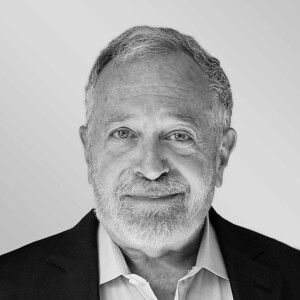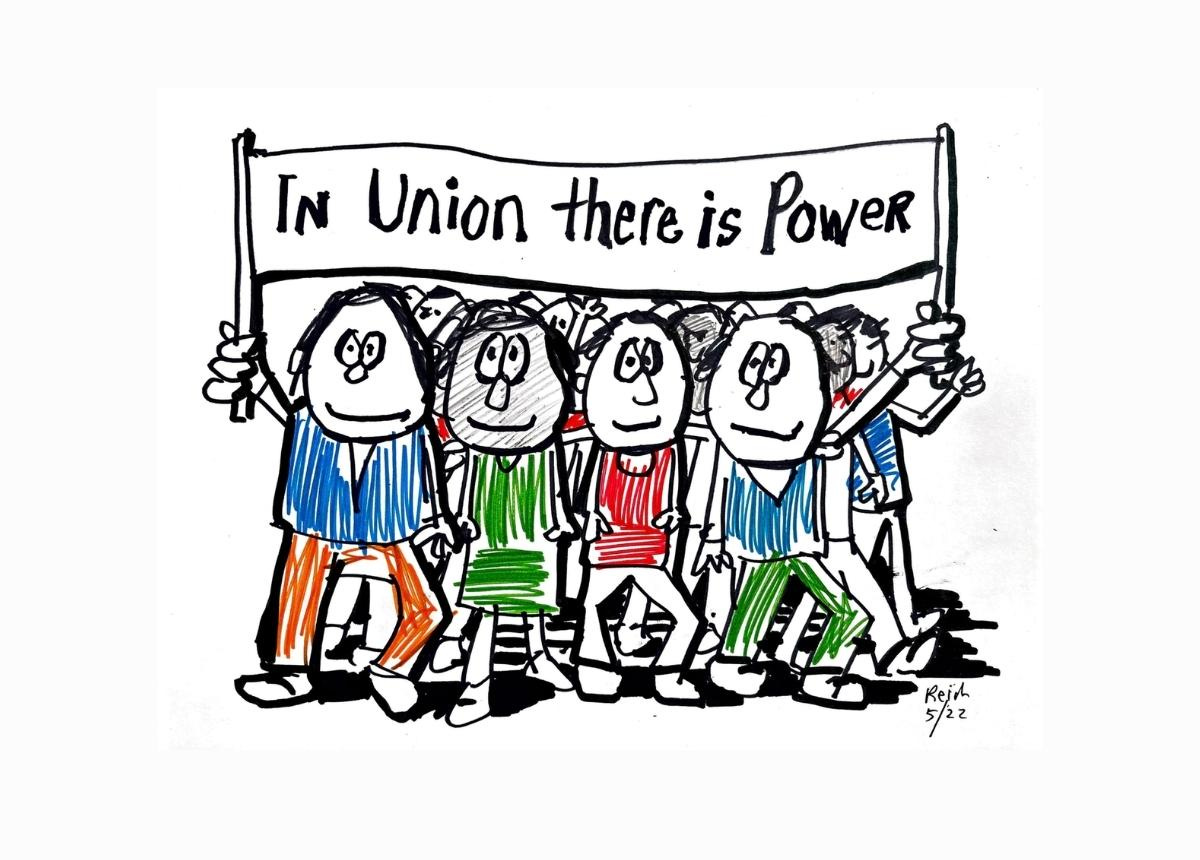
The Coffee Klatch with Robert Reich
News:Politics

Yesterday, the Game Workers Alliance (a union of quality assurance workers at Activism subsidiary studio Raven Software) won their vote to form a union. This may not seem like such a big deal, but it is. The games industry is large and growing. Quality assurance testers do the grunt work of rooting out bugs and potential problems in the weeks and months before games are released publicly. These jobs are typically among the lowest in the game industry, with demanding workloads finding and cataloging issues within a project’s timeframe. That these workers are unionizing marks a major turning point in worker organizing of the new economy.
Meanwhile, Starbucks Workers United has now unionized more than 80 Starbucks stores across the United States, and filed over 100 cases of unfair labor practices against the Seattle-based coffee giant. Howard Schultz, who returned to head the company in April, has a union busting record that goes back to the origins of the company, and is vowing to stop the drive toward unionization. But he can’t stop it.
Workers at a Trader Joe’s branch in Hadley, Massachusetts have begun organizing at the upscale supermarket chain. It would be the first unionized Trader Joe’s store out of more than 530 locations in the US. “We organized ourselves. With the same instinctive teamwork we use every day to break pallets, work the load, bag groceries, and care for our customers, we joined together to look out for each other and improve our workplace together,” workers wrote in an announcement letter to Trader Joe’s CEO, Dan Bane.
Workers at Amazon warehouses continue to organize, against fierce anti-union headwinds coming from Jeff Bezos and other Amazon executives.
Unions are coming to the new economy of grunt jobs in high-end corporations.
Between October 1, 2021 and March 30, 2022, the National Labor Relations Board recorded a 57 percent increase in workers filing for the petitions to allow union elections.
What’s going on?
1. Part of the reason for the upsurge is the so-called “labor shortage” which — as I’ve stressed — is actually a shortage of jobs paying living wages. At least for now, workers have bargaining leverage to demand better pay.
2. Another part is related to the pandemic and its psychological effect on many workers who have begun asking themselves why they’ve settled for lousy jobs and often unsafe working conditions, especially when corporations are scoring record profits and CEOs of big firms are taking home record multiples of the typical workers’ wages. More than at any other time in the last three decades, workers are telling employers “you can take this job and shove it.”
3. A third part of the revival of unions relates to America’s retreat from globalization. Four decades ago, when corporations began to move (or threaten to move) their operations offshore to hire lower-wage workers, American blue-collar workers lost their bargaining clout. Unions went into retreat. But starting with Trump and continuing with Biden — along with global supply bottlenecks that are now convincing corporations to bring suppliers home — outsourcing is in sharp decline. (Yesterday, Biden announced an agreement that he hopes represents the future of trade policy, known as the Indo-Pacific Economic Framework, which focuses on increased cooperation in areas like clean energy and internet policy rather than opening markets.)
4. A fourth reason: More college graduates are now in blue-collar jobs, many leading unionizing efforts.
5. A fifth reason is a new appreciation of the importance of power in driving wages, and the fraudulence of the economic idea that “you’re paid what you’re worth.”
The old economic mainstay that people are paid what they are “worth” is finally revealing itself to be an ideology grounded in nothing but power.
Let me pause here to spend a bit of time on this one, because it’s important.
According to this old mythology, minimum wage workers aren’t “worth” more than the $7.25 an hour federal minimum many now receive. If they were worth more, they’d earn more. Any attempt to force employers to pay them more will only kill jobs. According to this same ideology, CEOs of big companies are “worth” their giant compensation packages, now averaging 350 times pay of the typical American worker. They must be worth it or they wouldn’t be paid so much. Any attempt to limit their pay is fruitless because their pay will only take some other form.
Fifty years ago, General Motors was the largest employer in America. The typical GM worker then received over $35 an hour (in today’s dollars) — which came to over $70,000 a year (in today’s dollars). By contrast, America’s largest employers are now Walmart (whose typical worker earns about $15 an hour, or $30,000 a year for a full-time employee) and Amazon ($17 an hour, or $35,000 a year).
Does this mean GM employees a half-century ago were “worth” more than twice what today’s Walmart and Amazon employees are worth? Hardly. Those GM workers weren’t better educated or more productive than Walmart or Amazon workers are today. Fifty years ago, most GM workers hadn’t graduated from high school, and they worked on slow-moving assembly lines. Most of today’s Walmart and Amazon workers have graduated from high school; many have attended one or two years of college. And they’re surrounded by digital gadgets – mobile inventory controls, warehouse search engines, instant checkout devices – that make them enormously productive.
The real difference is GM workers a half-century ago had a strong union behind them that summoned the collective bargaining power of all autoworkers, enabling them to command a substantial share of company revenues for its members. And because more than a third of workers across America then belonged to a labor union, the bargains unions struck with employers raised the wages and benefits of non-unionized workers as well. (Non-union firms knew they’d be unionized if they didn’t come close to matching the union contracts.)
Most of today’s Walmart and Amazon workers don’t have a union to negotiate a better deal. They’re on their own. And because only 6 percent of America’s private-sector workers today are unionized, non-union employers across America don’t have to match union contracts. This puts unionized firms at a competitive disadvantage. The result has been a race to the bottom.
By the same token, today’s CEOs don’t rake in a record 350 times the pay of average workers because they’re “worth” 350 times the pay of average workers. CEOs are getting these giant pay packages (and top executives just behind them raking in almost as much) because they appoint the compensation committees on their boards that decide executive pay. Their boards also want investors to see that their company pays their CEO more than the average CEO at their major competitors, showing that their CEO is worth more. It’s the Lake Wobegon effect, where all CEO pay is above average. The result has been a CEO race to the top.
If you still believe people are paid what they’re “worth,” take a gander at Wall Street. Last year’s average bonus was up 20 percent over the year before, to more than $257,500 — the largest average Wall Street bonus since the 2008 financial crisis. (Remember, we’re talking bonuses, above and beyond salaries.)
Are Wall Street bankers really “worth” it? Not if you figure in the hidden subsidy flowing to the big Wall Street banks that ever since the bailout of 2008 have been considered too big to fail. People who park their savings in these banks accept a lower interest rate on deposits or loans than they require from America’s smaller banks. That’s because smaller banks are riskier places to park money. Unlike the big banks, the smaller ones won’t be bailed out if they get into trouble. This hidden subsidy gives Wall Street banks a competitive advantage over the smaller banks, which means Wall Street makes more money. And as their profits grow, the big banks keep getting bigger.
How large is this hidden subsidy? Researchers have calculated that it’s about eight tenths of a percentage point. This may not sound like much but multiply it by the total amount of money parked in the ten biggest Wall Street banks and you get a huge amount – well over $83 billion a year. That hidden subsidy going to Wall Street banks because they're too big to fail is almost twice what Wall Street paid out in bonuses (a total of $45 billion). Do the math. Without the subsidy, no bonus pool.
By the way, the lion’s share of that subsidy goes to the top five banks – JPMorgan, Bank of America, Citigroup, Wells Fargo. and Goldman Sachs — which just about equals these banks’ typical annual profits. In other words, take away the subsidy and not only does the bonus pool disappear, but so do the profits.
The reason Wall Street bankers got fat paychecks plus $45 billion in bonuses last year wasn’t because they work so much harder or are so much cleverer or more insightful than most other Americans. They cleaned up because they happen to work in institutions – big Wall Street banks – that hold a privileged place in the American political economy.
And why, exactly, do these institutions continue to have such privileges? Why hasn’t Congress used the antitrust laws to cut them down to size so they’re not too big to fail, or at least taxed away their hidden subsidy (which, after all, results from their taxpayer-financed bailout)? Could it be because Wall Street also accounts for a large proportion of campaign donations to major candidates for Congress and the presidency of both parties?
America’s low-wage workers don’t have privileged positions. They work hard – many holding down two or more jobs. They can’t afford to make major campaign contributions, and they have zero political clout.
Unions built the American middle class. Their demise almost exactly tracks the demise of America’s middle class and the growing share of total income going to the richest 10 percent. This graph makes this clear:
The “paid-what-your-worth” mythology ignores power, which means it ignores the single most important reason why hourly workers today are earning so little while corporate top brass are earning so much. For years, this ideology has lured the unsuspecting into thinking nothing should be done to change what people are paid because, they assumed, nothing could be done.
That’s finally changing. The revival of union activism across America suggests that workers are getting the message: If they want higher wages and better working conditions, they need the power to get them. To have power, they need a union.
What do you think?
This is a public episode. If you’d like to discuss this with other subscribers or get access to bonus episodes, visit robertreich.substack.com/subscribe
More Episodes
 2023-11-26
2023-11-26
 2023-10-28
2023-10-28
 2023-10-21
2023-10-21
 2023-09-10
2023-09-10
Create your
podcast in
minutes
- Full-featured podcast site
- Unlimited storage and bandwidth
- Comprehensive podcast stats
- Distribute to Apple Podcasts, Spotify, and more
- Make money with your podcast
It is Free
- Privacy Policy
- Cookie Policy
- Terms of Use
- Consent Preferences
- Copyright © 2015-2024 Podbean.com





